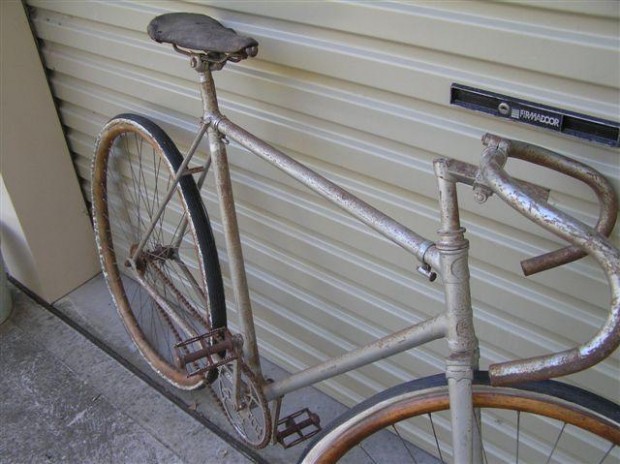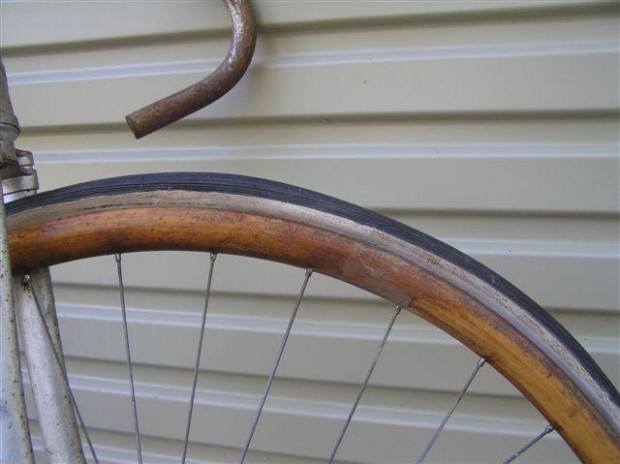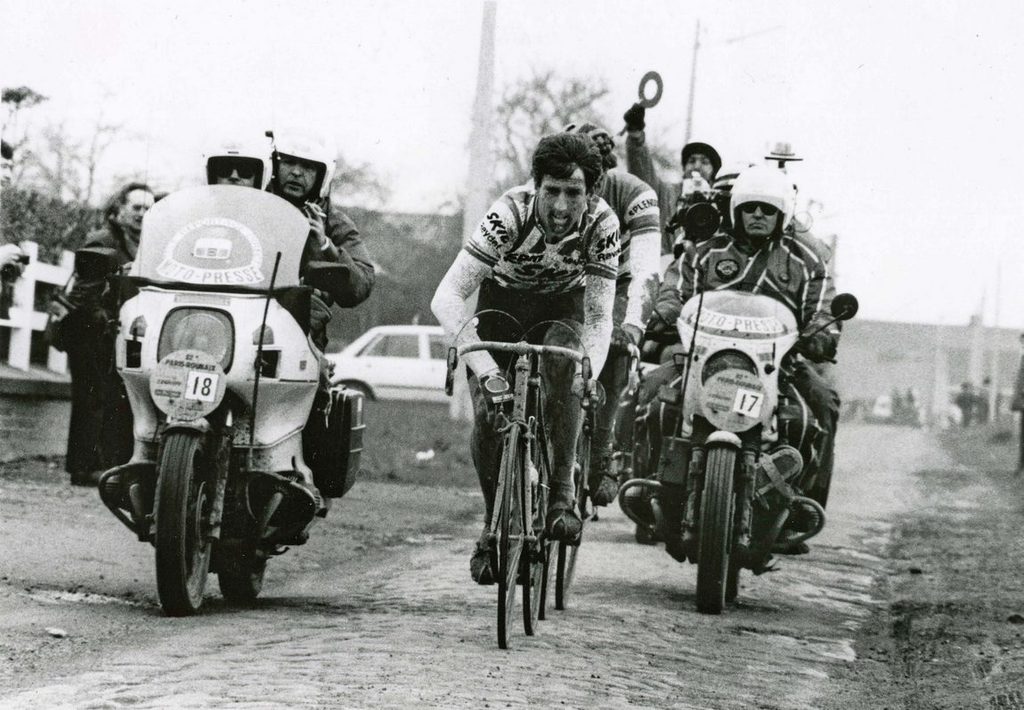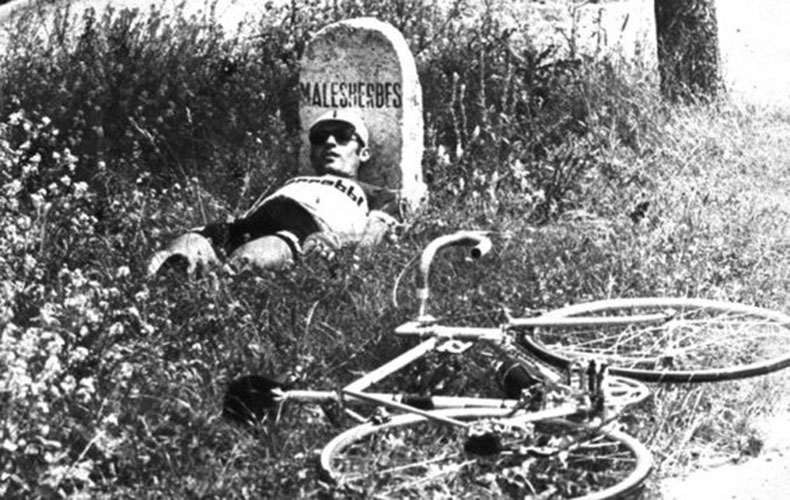Old School

We, as cyclists, as Velominati, may share a common passion, yet invariably have our roots planted in differing turf. Some may be late bloomers, coming to flower in our adult years, when we decide that a sedentary lifestyle, an expanding waistline or the realisation cycling is indeed more than just a sport or an activity, but a more spiritual experience than we ever were presented by ball sports or running or heaving lumps of iron into the air. Others, like me, have seemingly been enveloped in ‘la vie Velominatus’ for as long as our memories reach back.
My father Brian was never a cyclist, and while I’ve spent my life on two wheels, he has spent his as an artisan of other forms, using his hands, eyes and that part of the brain which triggers an appreciation for beauty, to collect and restore old furniture, cars, and even motorcycles. Where most see a paint-covered chest of drawers, or a rusting, flat-tyred relic, he sees the true identity, the former glory, and brings that back to life, and only then can others see what he had already envisioned before taking paint stripper, emery and French Polish to recreate a classic.
While growing up, through my life of bikes, there was always one bike ever-present, always there or thereabouts, yet one that was never ridden by me, or anyone else, never a pedal turned or a bar gripped. Forty-odd years, and all I ever knew this bike to do was just be there. Hanging on the garage wall, not even a complete entity, just a frame, a couple of wheels, handlebars turned sideways, the rest of the parts in ice-cream containers sitting on a bench or inside the latest restoration project, some old cabinet or dresser.
It never really intrigued me too much, didn’t jump out at me and say ‘ride me’. It was just there, a little sad probably that all these other newer, shinier steeds were getting my attention, yet when they would eventually be deemed too small, too old, or too inappropriate to my needs, would be moved on to other homes, or retired, in pieces, forever. But the old girl on the wall wasn’t going anywhere. Maybe she knew her day would yet come, that there were to be glory days yet again. Just a few years ago, I saw some bikes of the same era, the same ilk, the same brand even, that had been restored and converted into fixed-gear bikes, using a smattering of modern parts on their aging frames. The seed was planted in my mind that maybe I could give a new life to the old girl in a similar manner.
I floated the idea to Brian, who seemed to be accommodating to getting his old bike going again, but probably not in the way I had envisioned. No, if it was going to be done, then it would be done by him, in the only way known by him; back to its original condition and spec, right down to the paint colour, the decals, the lot. Parts were pulled from their ice-cream homes, the frame went off to his panel-beater mate, and parts which were either missing or too far gone to be used were replaced with as close to original that could be sourced. The bike shops of Newcastle were scoured for bits that most of their employees probably hadn’t even heard of or knew existed.
While my old-school fixie vision was scuppered, Brian’s old-school revitalisation vision was clear and concise. It may have taken a couple of years and more money than the bike was ever worth even in its glory days, but the result is more than worthy of both sacrifices. The bike has seen very little riding still, just a couple of trips down the driveway by myself, but that’s not the point. It is a piece of cycling history, my father’s history, and now my own history, as I will keep this machine as long as I live, even if I may never have a son or daughter of my own to pass it on to.
The story of the bike is one that was recounted to me when I was a youngster, then probably forgotten for a long time before the latest incarnation prompted me to delve deeper into the process that brought it into my father’s, and now my, life. In 1952, as an 11 year old boy living in the barren west of New South Wales, Brian asked his father if he could have a new bike, as the old hand-me-down he would ride to school, and around the property where they lived, was getting long in the tooth. His father, my grandfather, made him an offer, a bet, that if Brian could ride the old bike the 18 kilometres from Boorandah to Gilgandra in less than an hour, then the shiny new Speedwell Roadster would be his. 18km/h may not seem much to us now, but for an 11 year old, on a too-big, single speed bike along a dusty, gravel road in 35-degree heat, it probably seemed like trying for the Hour Record would to me.
When Brian arrived at Creenaune’s Cycles, he was to get the proprietor to phone his father and confirm that he had indeed made the cut-off and earned the bike. It must have seemed like winning a stage of the Tour, or having all his Christmases come at once. When the family moved from the outback to the coastal suburb of Belmont, the bike made the trip too, and would begin its term of inactivity. And now, here it is, in all its glory.
Speedwell Roadster, circa 1952.
28″ wheels. 3-speed Sturmey Archer gears. Williams cranks. Brooks B73 saddle. Brooks leather bar tape (new, wrapped by me). Brooks leather tool bag. New decals, reproduced from originals. Repainted rims, hand-lined pin-striping. Re-chromed original brakes, cranks, bars, pedals. Headset and bottom bracket original parts.
[dmalbum path=”/velominati.com/content/Photo Galleries/brettok@velominati.com/speedwell/”/]
The seed was planted, and a spate of ‘new’ old bikes started popping up in dad’s shed and under the house. Some were kind of cool, like the Peugeot folding bike, while others were more mainstream and not deemed as worthy of a rebuild. But one that came into his possession certainly did warrant an input of more time and coin.
This BSA track bike was sitting in his mate Jeff’s shed, and was bought for $40 (or maybe Jeff had bought it and passed it on). A circa 1900 beauty, its standout feature are the Bayliss-Wiley wood rims, which I’m informed (and Dad knows his wood) is Slovenian beech wood. These would be painstakingly hand stripped with window glass, and coated with seven coats of shellac. After having my former shop colleague Levi re-spoke them, they were still looking more like tacos than wheels, and would require three months under weights to get them in a condition that unfortunately won’t see them being ridden, but straight enough for display purposes.
Sourcing tyres for the wheels has been the bane of Brian’s existence though, their 28″/642 configuration impossible to find suitable rubber for. There are more chunky versions, like those on the Speedwell available, but to keep thing authentic requires a narrower, smoother tread, which has been so far elusive. The rims also look to me, and others, as if they could be tubulars; the originals were so so badly perished that it was difficult to tell if the tube and tyre were supposed to be bonded together or not. If there are any tyre/wheel/old bike experts out there that can help, please get in touch.
As can be seen from the finished product, time, effort and an artisan’s touch have garnered outstanding results.
BSA Track bike
Original BSA bottom bracket, cranks, chainring, pedals, stem, bars. French Atom front hub, BSA rear hub. Finished in Mimosa yellow 2 pack paint. Brooks saddle. Bayliss-Wiley wood rims.

[dmalbum path=”/velominati.com/content/Photo Galleries/brettok@velominati.com/BSA/”/]


Absolutely beautiful! Both of them. And the article, too. I’ve just spent the last week wandering around Cambridge, MA. As with so many college towns, the place is teeming with bicycles. Most of them ugly and eminently forgettable, but I’ve seen a few gems that would be very special with a little work. They’re either locked to a sign, wall, lamppost, or they’re in action, and I wonder if their owners realize and/or appreciate what it is they’re riding. Time, space, and money won’t permit it anytime soon, but I’d love to engage in a personal and local bike rescue project, taking in local classics and restoring them to their former splendor.
phenomenal refurb man, absolutely right all the way around.
I cannot imagine the countless hours of cleaning, getting the materials ready for final prep, looking for the right goods to deck them out with and etc.
You did it so justly. Not a wrong choice made, not one.
Put that feather in your cap and wear it proud.
Beautiful.
As for the wood rims, did they have anything other than tubs in those days?
@Jarvis
Yeah, pretty certain they are tubs, but they have a small lip/hook that is similar to the rims on the old Speedwell, which takes clinchers. The tyres/tubes that were bonded to the wood rims appeared to be clinchers that were glued on, but they were so gunked together that it was hard to tell what they were. It didn’t appear that the tube was fully encased in the tyre.
Any slick, narrow racing-style tyre in that size is proving a real bitch to find, and only needs to be good enough for the bike to be displayed, not ridden.
What a tale, WHAT A TALE! My Merckx, that’s the stuff right there. Well done, mate, on both the article as well as the restorations.
I’ve spotted pictures of the Speedwell around, must have been on your personal site. What a masterpiece. And that track bike, mon dieu!! Those wood rims, help me…
I’ve been dreaming a while now about building up an 80’s-era bike with Record, but maybe I need to refocus on something more like this, a real relic.
Also, the re-chromed bits are an inspiration. I recently came into this, which is my Velomihottie’s original bike. It was dropped off by here parents when they visited this past summer, and I’ve had the itch to rebuild it ever since, but the chrome bits seemed too hard to restore…but now, I have new inspiration.
The bell works, by the way.
Thanks, mate, great story.
*bites knuckle ala Sonny Corleone*
Oh, and I love that adjustable stem on the track bike!
@Frank
forget restoring your Velomihottie’s old bike, what you need to do is to go to a nice, flowing downhill trail and feel the freedom of riding an inappropriate bike off-road.
that BSA is an absolute stunner of a bike. There was an article in august’s (i think) procycling rag where one of the writers rode up the tourmalet on a restored 1929 victor fontan special edition. I might have to restore my dad’s whitcomb into the 60’s TT bike it used to be, rather than my fixie…
Wow, talk about bike porn. Both bikes look great. Must have been great projects.
One of the great stories.
Yes the bikes are beautiful, but to think of an 11yr old having to put it on the line like that. Absolute Rule #5 gold. I’ve been to Gilgandra, although it was well above 40degrees when I was there, so maybe it’s not SO difficult an ask of a young boy…!!!!
Chapeaux
A++1. Great article, mate. And perfectly timed – after all that splashing around in the angst pool bemoaning doping it’s great to have something to focus us on the good things in (cycling) life. Accentuate the positive and all that …
Here’s a ‘before’ shot of the Speedwell…
Great article and beautiful restoration. I’m always amazed and impressed by people with the skills to do such work, whether it’s a complete restoration or even a bike build — I’m mechanically challenged, if only because I never had anyone to apprentice with (father couldn’t program a VCR). I am stunned by the before and after pictures. There was obviously a clear “vision” regarding the potential of this bike.
Awesome story – that red Speedwell is gorgeous!
In my “Transformation” story I mentioned seeking employment with Bridgestone in San Leandro. I didn’t get hired by them but I got a job at a little Schwinn shop in San Lorenzo. The only mechanic on staff at the time was a big burly Harley mechanic that could fix bikes but had not the heart of a cyclist. It didn’t take long before the owner of the shop saw that I was a “super-freak” when it came to bikes and so he went into the back room and drug out and old cardboard bike box and inside was a 1939 Paramount track bike. He said “I’ve been waiting for somebody like you to come around.” He also had all this literature about the bike from the Schwinn museum in Chicago. I was amazed to learn that in 1939 the frame was made from seamless 4130 chromoly. Then I got to the wheels. Wooden sew-up rims! Wooden sew-up rims with double-butted spokes. I unlaced the wheels so that I could sand and refinish the rims and found another interesting fact – the hubs were large flange with Schwinn script engraved on them and looked pretty old-school but looks can be deceiving. Dis-assembly revealed that the bearing surfaces had the same appearance of the precisely machined and finely ground bearing surfaces of a Campy Record hub. The other interesting thing was that there were no lock nuts for the bearing cones and the cones themselves had no threading. The axle was likewise sans threads where the cones sat. The cones just free-floated on the axle and self-adjusted with the tightening of the axle nuts on the drop outs. After much polishing and rebuilding the hubs with new bearings and tenacious oil the hubs were indeed as smooth as anything that Campy has ever produced. I re-laced the wheels with new stainless steel double-butted spokes (the old ones were very corroded) and they trued up completely straight and round and were very light. We hung them proudly above the sales counter but sadly I returned to Oregon before I could complete work on the rest of the bike.
Brett, you did that bike such a big favor. I mean, who on earth puts street BMX grips on the drop bar anyway….
At least the speedwell lady rewarded you most favorably
@Souleur
I did none of the restorations, it was all my father’s doing.
But, I have a feeling I may have put those grips on during my younger BMX days, probably thinking of some way to make it into a jump bike or some dirt-going beast! And then giving up when i realised the condition of the rest of the bike…
We need to see a pic of you wearing knee-socks, knickers, and an argyle sweater vest whilst riding that Speedwell. What a cool bike and darn awesome bar tape. Restoring all the little nooks and crannies of that chrome must have been quite the chore.
Everytime I go to the dump I source the scrap metal pile for old bikes. I haven’t seen any yet that I feel are worth puting that kind of dedication into but one of these days something will turn up.
Great article man. Thanks.
oh, and here a company making wooden rims these days. I’ve seen their ad in the back of cycling mags. seems that would be a cool one-off option to put on the BSA so you can ride that too.
wood
and for pricing, check out this ebay listing. that bsa may be worth something
Didn’t know where the best place for this was, but does anyone know where I can get some vintage bottle holders that go on the stem?
@Steampunk
I’ve got one that goes on the bars. I purchased it for my fixie a while back. I’ve seen those at various shops. The stem ones though, sorry, I just realized this reply is no help.
@Marko
You’re on the right track. This is for a fixie build I’m working on this winter (and ostensibly for my Velomitoddler’s juice cup). I may well resort to the one that goes on the bars, but there’s something very cool about the older cages that straddled the stem.
@Steampunk
Sorry to be a late responder. Chances are if it’s in cambridge and is worth restoring the person on it knows what it is. The real golden stuff is in the hands of the local shoprats; Paramounts, Peter Mooneys, Richard Sachs ect that have been passed down from coworker to coworker for the last 40 years.
Stunning work-a true work of art